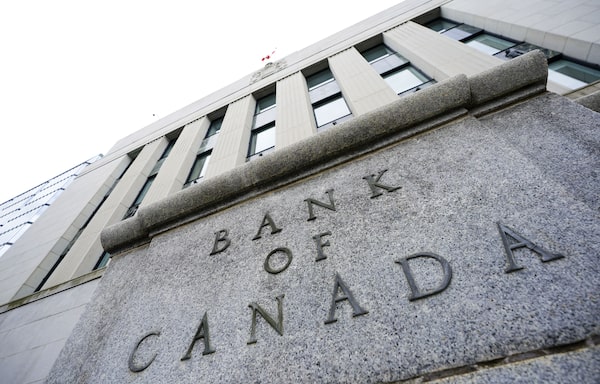
The Bank of Canada in Ottawa on July 12, 2022.Sean Kilpatrick/The Canadian Press
We don’t have a lot to go on, yet, to explain why the Bank of Canada pushed aside its short-lived pause and raised interest rates again. But based solely on the text of Wednesday’s rate announcement, it might have been simple arithmetic.
The central bank appears to have done some math around the stronger-than-expected, first-quarter economic growth data, and abandoned its wait-and-see stand in favour of resuming rate hikes. In the five-paragraph statement that served as the day’s only supporting document for the policy shift, the phrase “excess demand” – absent from rate-decision statements during the bank’s three-month pause in rate hikes – returned with conspicuous prominence.
“Overall, excess demand in the economy looks more persistent than anticipated,” the bank said, in what we can consider the operative sentence in the statement.
Meanwhile, other indicators that the central bank had said would be its focus in determining future rate moves – such as wage growth, inflation expectations and business pricing behaviour – barely made an appearance, and certainly no ripple.
The implication is that the calculations around the overall excess demand in the economy have refocused the bank’s attention and revived a sense of urgency. The bank’s willingness to wait calmly on the sidelines, while last year’s big wave of rate hikes worked its way through the economy, didn’t survive a single quarterly GDP report.
This is the kind of back-of-the envelope calculation that must have been a big part of that flip-flop.
Last week’s GDP report pegged first-quarter growth at a 3.1-per-cent annualized rate, well above the bank’s most recent estimate of 2.3 per cent. That figure exceeds the economy’s estimated pace of capacity growth – which means demand grew faster than supply. So, excess demand grew in the quarter, and ended the quarter bigger than the bank had expected. The GDP report also contained a preliminary April growth estimate that suggested that the momentum had continued into the second quarter.
If the economy is in greater excess demand, for a longer time than the Bank of Canada had forecast, then the inflation pressures implied by that imbalance will also be higher for longer.
Now, the bank forecast in its quarterly projections in April that inflation wouldn’t retreat to the 2-per-cent target until the end of 2024, which is toward the outer limits of the 18- to 24-month horizon on which interest-rate policy is built. If you bake the stronger-than-expected first four months of 2023 into the calculus, the implication is that inflation doesn’t return to 2 per cent until some time in 2025 – barring some greater slowdown during the forecast horizon to offset that stronger growth.
How do you get slower growth in future months into the calculation? You assume a higher interest rate.
How does the Bank of Canada work?
The bank could have waited until its mid-July rate decision – when it will have the benefit of new quarterly projections from its economists – to recalculate and raise rates. But the substance of the math isn’t going to change. Unless the economy is slower than the bank has previously forecast over the next year-and-a-half, it’s not going to achieve its 2-per-cent inflation target over the time frame on which monetary policy is set. The bank clearly didn’t want to wait to apply more economic brakes.
To be fair, the bank has said all along that it was prepared to resume rate increases if conditions warranted. Perhaps it wasn’t as clear as it could have been about which conditions. But we could have reasonably assumed that a substantive increase in excess demand would be a key factor; the gap between overall supply and demand in the economy is always central in setting monetary policy.
Still, Governor Tiff Macklem repeatedly talked about requiring “an accumulation of evidence” before resuming rate hikes – the implication being that the bar had been set high to move the bank off the sidelines. Instead, a single quarter of surprisingly high GDP growth – together with a single month’s small uptick in inflation, and some more recent signs of life in housing activity – shook the bank’s resolve. Despite having pledged a wait-and-see approach, it seems that the bank is not, in fact, willing to wait and see if those surprises are short-term blips.
The big question now is, where do we go from here? In the absence of a quarterly Monetary Policy Report (the next one comes out with the July rate decision) and an accompanying news conference with the Governor, we’re left sifting through the rate announcement for clues.
The final paragraph of the statement – where the bank typically signals future direction – only says that the bank’s governing council will “continue to assess the dynamics of core inflation and the outlook for [consumer price index] inflation.” Notably, however, the bank didn’t say it would assess whether rates are “sufficiently restrictive,” as it did in the April statement. This absence, perhaps, suggests that another rate hike in July is not in the bank’s base scenario.
We can hope that Thursday’s post-announcement speech and news conference from deputy governor Paul Beaudry sheds light on the bank’s thinking, both around Wednesday’s rate increase and the future direction. With excess demand resuming centre stage, the bank has a fair bit of explaining to do.